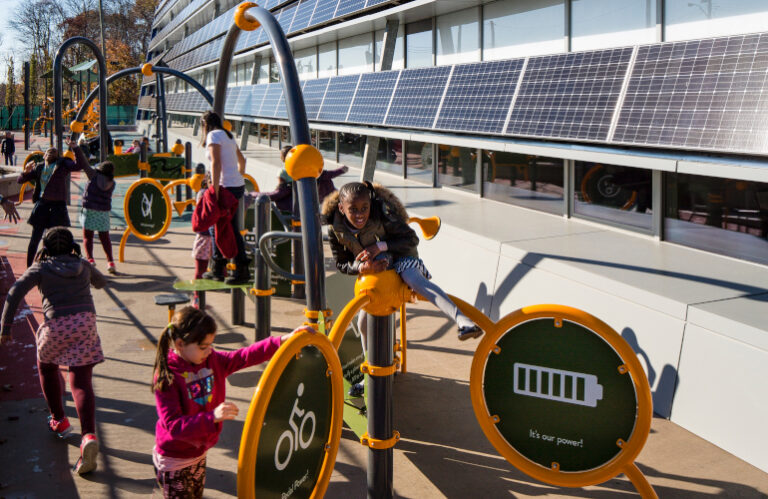The amount of solar capacity installed in primary schools has more than quadrupled nationally in the past decade, according to a study new report from a clean energy nonprofit Generation180.

A solarized school in New York City. Credit: James Ewing
The report ‘Brighter Future: A Study of Solar on K-12 Schools, 5th edition’ shows that more than 6.2 million American primary school students – or more than one in nine students – now attend a school that uses solar energy . . By 2022-2023, more than 800 schools will have installed solar panels, which is enough to power at least one school every day.
“The benefits of solar energy are now reaching a wide range of schools across the country, including schools in under-resourced communities that will benefit most from the cost savings and educational opportunities that solar technology provides. We want all schools and communities, regardless of size, geography or wealth, to have access to affordable, clean energy,” said Tish Tablan, lead author of the report and senior director of Generation180’s. Electrify our school program.
The report shows that most primary schools transitioning to solar energy finance their projects through third-party ownership models that remove the barrier of upfront capital costs. The Inflation Reduction Act created the opportunity for schools to reduce the cost of clean energy projects through tax credits – paid as cash refunds – for solar panels, battery storage and other clean energy technologies.
The Brighter Future report also shows that:
- With a cumulative solar capacity of 1,814 MW, our country’s primary schools generate enough solar energy to power the electricity consumption of all households in Denver, Colorado – more than 330,000 households.
- The top five states for school solar capacity – California, New Jersey, Arizona, Massachusetts and Connecticut – have contributed to the national growth of school solar.
- Minnesota, Maryland and Pennsylvania are three innovative states that have established state-funded grant programs to support school solar adoption.

School buses under a solar carport in California. Credit: Borrego Solar
Schools with solar power reap the benefits of energy cost savings that can be reinvested back into students and communities. Wayne County Public Schools will be the first in West Virginia to power all school buildings with solar power by 2025. Although historically dependent on coal energy in the past, the district is now installing 10,000 solar panels on its school grounds and offering apprenticeships that will provide vocational training to colleges. students and enable them to help install solar energy in their own schools.
Schools that combine battery storage with solar energy help their communities become climate resilient. About 40 schools in six states have installed battery storage in addition to their solar panels to manage their grid energy use and provide backup power to their buildings. More than 75% of installed battery projects in elementary schools are in California, which has one of the longest-running storage incentive programs in the country.
Schools participate in community solar projects that extend electric bill savings beyond the boundaries of school campuses. In Denver, Colorado, solar canopies installed in schools provide affordable, clean electricity to low-income families living in the community. The City of Denver and Denver Public Schools are partnering on this community solar program that is currently saving 44 local families an estimated 64% on their household electricity costs.
“While we are pleased to see the growth in the use of solar energy, too many schools are still missing out on the many benefits that solar energy brings to students, communities and the climate. We hope this report helps more schools see what is possible in their own districts and inspires them to participate in our country’s clean energy transition,” said Stuart Gardner, executive director of Generation180.
News item from Generation180


